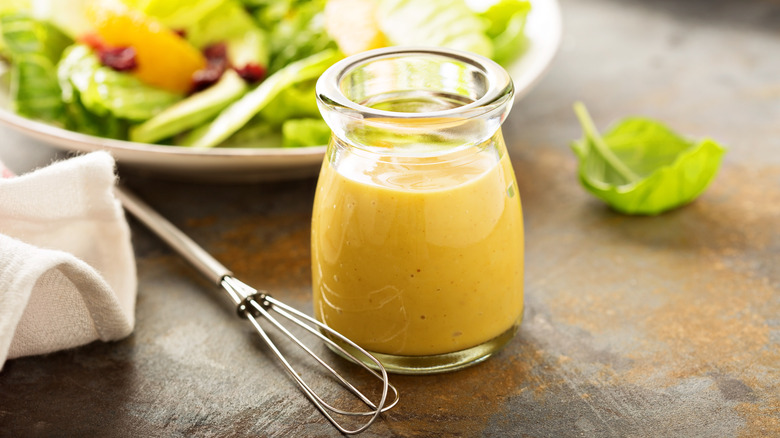The Condiment You Should Add To Punch Up Homemade Vinaigrettes
There are plenty of quality salad dressings on the market, but there is truly something special about tasting a homemade vinaigrette on a fresh salad, or spooned delicately over a main-course protein. The beauty of a vinaigrette is that you can create numerous variations on a theme depending on what you're serving it with. In its simplest form, a vinaigrette is a mixture of oil and acids. Olive oil, grapeseed oil, or even walnut oil are mixed with vinegar and lemon juice. Beyond that, the flavoring is up to the individual cook or chef. Some will add herbs or spices, Dijon mustard, minced garlic or shallot ... The possibilities are endless.
A vinaigrette's flavor can also change drastically depending on what kind of vinegar you use. Rice wine vinegar, red wine vinegar, white vinegar, aged balsamic, and apple cider vinegars all have unique and different tastes that will be imparted on the dressing. If you don't have any fancy vinegar in your pantry, there is another ingredient you can add to your next vinaigrette to give it a distinctive and memorable flavor. And odds are this ingredient is already in your refrigerator door.
A few dashes of Worcestershire sauce
Sit down with a group of five friends and each person might pronounce this ingredient differently, but Worcestershire sauce is a unique way to give your next vinaigrette a unique, rich, umami flavor. The base of Worcestershire sauce is vinegar, so it's a natural ingredient to be incorporated into a vinaigrette. The vinegar base is mixed with anchovies, molasses, tamarind, garlic, and onion giving the sauce its unique, rich signature flavor. It has similar notes to a soy sauce or fish sauce, but it's also its own thing. It should be noted, however, that due to the anchovies in the sauce, the original Worcestershire condiment is not considered vegan or vegetarian-friendly. So if you happen to be cooking for those who don't consume fish products, you might try finding a vegan version of the condiment, or an alternative like soy sauce or tamari instead.
In a vinaigrette recipe that calls for the juice of one lemon, a half cup of oil, and two tablespoons of vinegar, try adding just one tablespoon of Worcestershire sauce to the mixture to get a nice balance. If you're unfamiliar with the taste of it, start with a bit less and work your way up to adding a few dashes more. This unexpected twist could up-level a simple vinaigrette into one of the best dressings of your culinary life.
Oh, by the way, it's pronounced, "wu·stuh·shr."

